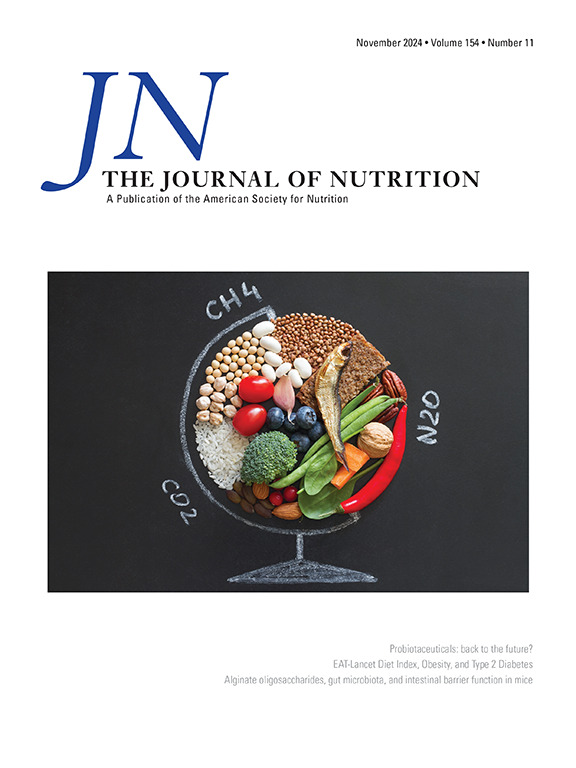Impact of Probiotic Lacticaseibacillus paracasei Strain Shirota (LcS) on Aflatoxin Exposure among Healthy Malaysian Adults: A Randomized, Double-Blind, Placebo-Controlled Intervention Study
IF 3.7
3区 医学
Q2 NUTRITION & DIETETICS
引用次数: 0
Abstract
Background
Limited evidence suggests that probiotic Lacticaseibacillus paracasei strain Shirota (LcS) may reduce aflatoxin exposure in Malaysians, though individual factors influencing aflatoxin exposure remain unclear.
Objectives
This study evaluated the effect of LcS on aflatoxin biomarker concentrations over a 12-wk intervention among healthy Malaysian adults. A secondary objective was to explore the individual factors associated with aflatoxin exposure using baseline data.
Methods
A randomized, double-blind, placebo-controlled intervention involved healthy Malaysian adults (aged 20–60) of Chinese, Malay, or Indian ethnicities with elevated urinary aflatoxin M1 (AFM1) and serum aflatoxin B1 (AFB1)-albumin concentrations. Hundred and seventy-four (n = 174) subjects were randomly and equally assigned (n = 87/group) to consume either fermented milk with LcS (probiotic) (3 × 1010 CFU/80 mL/bottle) or milk without LcS (placebo) twice/d for 12 wk, with a 4-wk follow-up. Baseline data included sociodemographic characteristics, knowledge, attitude, and practice related to aflatoxin contamination, dietary intake, body weight, and physical activity status. Urine and fasting blood samples were collected every 2 and 4 wk for AFM1 and AFB1-lysine adduct analyses, respectively.
Results
Eighty-five (n = 85) and 82 (n = 82) subjects in the probiotic and placebo groups completed the intervention, respectively. After adjusting for covariates, a significant effect was observed at postintervention in the probiotic group with a 23% reduction in urinary AFM1 concentrations compared with the placebo group (B = –0.26; Exp(B) = 0.77; P = 0.04). Serum AFB1-lysine adduct concentrations remained lower in the probiotic group throughout the study. Both aflatoxin biomarkers significantly differed by ethnicity (AFM1: P = 0.001; AFB1: P = 0.01). Subjects with lower aflatoxin knowledge had significantly higher AFB1-lysine concentrations (mean rank = 95.99) than those with higher knowledge (mean rank = 73.57) (P = 0.04). Urinary AFM1 concentrations were higher with cereal intake (ρ = 0.17, P = 0.03) but lower with protein intake (ρ = –0.18, P = 0.02).
Conclusions
Ethnicity, knowledge level, and dietary intake influenced aflatoxin exposure. The benefits of consuming LcS to reduce aflatoxin exposure deserve further attention.
Trial registration number
This trial is registered in the National Medical Research Register (NMRR-16-2693-3230) and clinicaltrials.gov (NCT03882294).
益生菌副干酪乳杆菌(LcS)对健康马来西亚成年人黄曲霉毒素暴露的影响:一项随机、双盲、安慰剂对照干预研究。
背景:有限的证据表明,益生菌副干酪乳杆菌菌株Shirota (LcS)可能减少马来西亚人的黄曲霉毒素暴露,尽管影响黄曲霉毒素暴露的个别因素仍不清楚。目的:本研究评估了LcS在12周干预期间对马来西亚健康成人黄曲霉毒素生物标志物浓度的影响。第二个目的是利用基线数据探讨与黄曲霉毒素暴露相关的个体因素。方法:一项随机、双盲、安慰剂对照的干预,涉及尿黄曲霉毒素M1 (AFM1)和血清黄曲霉毒素B1 (AFB1)-白蛋白浓度升高的健康马来西亚成年人(20-60岁),华人、马来人或印度人种族。174名受试者(n = 174)被随机平均分配(n = 87/组),饮用含益生菌的发酵乳(3 × 1010 CFU/80 mL/瓶)或不含益生菌的乳(安慰剂),每天两次,持续12周,随访4周。基线数据包括社会人口学特征、与黄曲霉毒素污染有关的知识、态度和行为、饮食摄入、体重和身体活动状况。每2周和4周分别采集尿液和空腹血进行AFM1和afb1 -赖氨酸加合物分析。结果:益生菌组和安慰剂组分别有85名(n = 85)和82名(n = 82)受试者完成了干预。在调整协变量后,与安慰剂组相比,益生菌组干预后尿AFM1浓度降低23% (B = -0.26;Exp(B) = 0.77;P = 0.04)。在整个研究过程中,益生菌组的血清afb1 -赖氨酸加合物浓度保持较低。两种黄曲霉毒素生物标志物在种族上有显著差异(AFM1: P = 0.001;Afb1: p = 0.01)。黄曲霉毒素知识水平较低的受试者afb1 -赖氨酸浓度(平均rank = 95.99)显著高于知识水平较高的受试者(平均rank = 73.57) (P = 0.04)。尿AFM1浓度随谷类摄入而升高(ρ = 0.17, P = 0.03),随蛋白质摄入而降低(ρ = -0.18, P = 0.02)。结论:种族、知识水平和饮食摄入影响黄曲霉毒素暴露。食用低糖以减少黄曲霉毒素暴露的益处值得进一步关注。试验注册号:本试验已在国家医学研究注册(NMRR-16-2693-3230)和clinicaltrials.gov (NCT03882294)注册。
本文章由计算机程序翻译,如有差异,请以英文原文为准。
求助全文
约1分钟内获得全文
求助全文
来源期刊

Journal of Nutrition
医学-营养学
CiteScore
7.60
自引率
4.80%
发文量
260
审稿时长
39 days
期刊介绍:
The Journal of Nutrition (JN/J Nutr) publishes peer-reviewed original research papers covering all aspects of experimental nutrition in humans and other animal species; special articles such as reviews and biographies of prominent nutrition scientists; and issues, opinions, and commentaries on controversial issues in nutrition. Supplements are frequently published to provide extended discussion of topics of special interest.
 求助内容:
求助内容: 应助结果提醒方式:
应助结果提醒方式:


